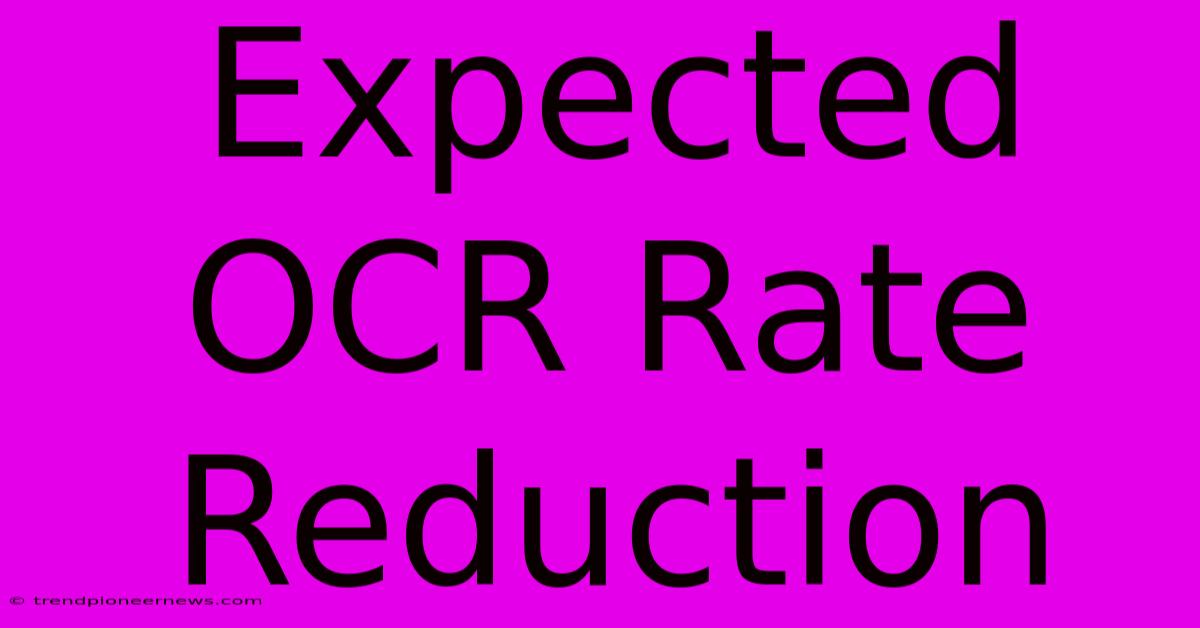Expected OCR Rate Reduction

Discover more detailed and exciting information on our website. Click the link below to start your adventure: Visit Best Website Expected OCR Rate Reduction. Don't miss out!
Table of Contents
Expected OCR Rate Reduction: My Epic Fail and What I Learned
Hey everyone! So, I recently tackled a HUGE project – digitizing a mountain of old documents. I'm talking thousands of pages, mostly handwritten notes from my grandpa's research. I thought, "Piece of cake! I'll just use OCR software, and bam, instant digital archive." Boy, was I wrong. I mean, so wrong.
The Great OCR Expectation Crash
My initial plan was simple: bulk upload, hit "process," and celebrate. I figured a good OCR engine would have no problem with neat handwriting, right? Wrong again. The expected OCR rate reduction, which I foolishly assumed would be minimal, was… well, nonexistent in some cases. I got back a bunch of gibberish. Seriously, it was like the machine had learned to write in a completely new language, one that only it could understand.
I was so frustrated! I'd spent hours scanning and prepping everything, only to end up with a digital mess that was less useful than the original paper. Talk about a major time-suck. I felt like I'd wasted a whole weekend. I started questioning my sanity. Was it even possible to get a decent OCR rate reduction?
Lessons Learned: Don't Be a Dummy Like Me
Okay, so, here's the brutal truth: OCR isn't magic. It's technology, and like all technology, it has its limitations. My biggest mistake was assuming it'd work flawlessly without any prep work. My expected OCR rate reduction was way off because I didn't understand the software's limitations.
Here's what I learned the hard way, and what I wish I knew beforehand:
-
Image Quality is King: Seriously, clear scans are essential. Blurry or poorly lit images are the enemy of accurate OCR. Invest in a good scanner, and use consistent lighting. Think crisp, professional photographs! The better your images, the lower your error rate. Aim for 300 DPI for best results.
-
Preprocessing is Your Friend: Before even thinking about OCR, you need to pre-process your documents. This means straightening crooked scans, removing shadows or creases, and maybe even cropping the images. You can use programs like GIMP (it's free!) to do this. It's tedious, but it's a game-changer for OCR accuracy.
-
Choose Your Software Wisely: Not all OCR software is created equal. Some are better suited for specific tasks, like handwriting or printed text. Do your research; find something reputable and reliable. Look at user reviews and try out free trials if possible. Free software is usually good enough, and if you have many documents to process, you can use multiple free applications.
-
Expect Imperfections, Edit Accordingly: Even with perfect prep, you'll likely still have errors. Don't expect a 100% accurate OCR rate reduction. Plan for a post-processing editing phase. Treat it as proofreading; use the processed text as a base and manually fix those inevitable errors. This is where it really takes patience.
Getting Real About OCR Rate Reduction
So, to summarize, my initial naive hope of a near-perfect OCR rate reduction was, let's be honest, incredibly unrealistic. I had a false expectation that completely backfired. However, after a lot of trial and error, some serious learning curves, and a whole lot of frustration, I eventually got a much better result. I learned that good OCR results require preparation, the right tools, and an acceptance that you will have some post-processing tasks to perform.
I hope this helps you avoid my mistakes! Don't be like me – do your homework and approach OCR with realistic expectations. You'll save yourself a lot of headaches (and maybe a few weekends). Good luck!

Thank you for visiting our website wich cover about Expected OCR Rate Reduction. We hope the information provided has been useful to you. Feel free to contact us if you have any questions or need further assistance. See you next time and dont miss to bookmark.
Featured Posts
-
Use Robust Statistical Models Don T Be Afraid To Use Advanced Tools Or Statistical Methods To Increase Accuracy
Nov 27, 2024
-
Eloise Beda Cortland Ohio Resident
Nov 27, 2024
-
About Eloise Sisley Beda Ohio
Nov 27, 2024
-
Watch Barcelona Brest Online
Nov 27, 2024
-
Nih Head Anti Mandate Doctor Chosen
Nov 27, 2024
